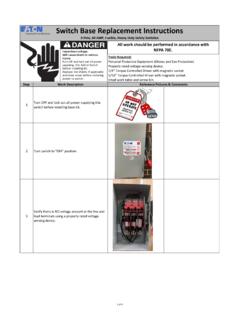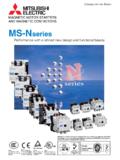Transcription of Chapter 8 Introduction to Magnetic Fields - MIT
1 Chapter 8 Introduction to Magnetic Fields The Definition of a Magnetic Magnetic Force on a Current-Carrying Example : Magnetic Force on a Semi-Circular Torque on a Current Magnetic force on a Animation : Torques on a Dipole in a Constant Magnetic Charged Particles in a Uniform Magnetic Animation : Charged Particle Moving in a Uniform Magnetic Velocity Mass Problem-Solving Solved Rolling Suspended Conducting Charged Particles in Magnetic Bar Magnet in Non-Uniform Magnetic Conceptual Additional Force Exerted by a Magnetic Magnetic Force on a Current Carrying Sliding Particle Particle Orbits in a Magnetic Force and Torque on a Current Force on a Levitating 8-1 Introduction to Magnetic Fields Introduction We have seen that a charged object produces an electric field EGat all points in space.
2 In a similar manner, a bar magnet is a source of a Magnetic field BG. This can be readily demonstrated by moving a compass near the magnet. The compass needle will line up along the direction of the Magnetic field produced by the magnet, as depicted in Figure Figure Magnetic field produced by a bar magnet Notice that the bar magnet consists of two poles, which are designated as the north (N) and the south (S). Magnetic Fields are strongest at the poles. The Magnetic field lines leave from the north pole and enter the south pole. When holding two bar magnets close to each other, the like poles will repel each other while the opposite poles attract (Figure ).
3 Figure Magnets attracting and repelling Unlike electric charges which can be isolated, the two Magnetic poles always come in a pair. When you break the bar magnet, two new bar magnets are obtained, each with a north pole and a south pole (Figure ). In other words, Magnetic monopoles do not exist in isolation, although they are of theoretical interest. Figure Magnetic monopoles do not exist in isolation 8-2 How do we define the Magnetic field BG? In the case of an electric field E, we have already seen that the field is defined as the force per unit charge: G eq=FEGG ( ) However, due to the absence of Magnetic monopoles, BGmust be defined in a different way.
4 The Definition of a Magnetic field To define the Magnetic field at a point, consider a particle of charge q and moving at a velocity. Experimentally we have the following observations: vG (1) The magnitude of the Magnetic force BFGexerted on the charged particle is proportional to both v and q. (2) The magnitude and direction of BFG depends on vG and BG. (3) The Magnetic force vanishes when BFGvG is parallel toBG. However, when v makes an angle G with , the direction of BGBFG is perpendicular to the plane formed by and vGBG, and the magnitude of is proportional to BFGsin . (4) When the sign of the charge of the particle is switched from positive to negative (or vice versa), the direction of the Magnetic force also reverses.
5 Figure The direction of the Magnetic force The above observations can be summarized with the following equation: Bq= FvBGGG ( ) 8-3 The above expression can be taken as the working definition of the Magnetic field at a point in space. The magnitude of BFG is given by ||sinBFqvB = ( ) The SI unit of Magnetic field is the tesla (T): NewtonNN1tesla1T111(Coulomb)(meter/secon d)Cm/sAm==== Another commonly used non-SI unit for BGis the gauss (G), where.
6 41T10G= Note that is always perpendicular toBFGvG and BG, and cannot change the particle s speed v (and thus the kinetic energy). In other words, Magnetic force cannot speed up or slow down a charged particle. Consequently, BFG can do no work on the particle: ()()BdWdqdtqdt= = =Fs=vBvvvBGGG0 GGGGG ( ) The direction of , however, can be altered by the Magnetic force, as we shall see below. vG Magnetic Force on a Current-Carrying Wire We have just seen that a charged particle moving through a Magnetic field experiences a Magnetic force . Since electric current consists of a collection of charged particles in motion, when placed in a Magnetic field , a current-carrying wire will also experience a Magnetic force.
7 BFG Consider a long straight wire suspended in the region between the two Magnetic poles. The Magnetic field points out the page and is represented with dots ( ). It can be readily demonstrated that when a downward current passes through, the wire is deflected to the left. However, when the current is upward, the deflection is rightward, as shown in Figure Figure Deflection of current-carrying wire by Magnetic force 8-4 To calculate the force exerted on the wire, consider a segment of wire of length A and cross-sectional area A, as shown in Figure The Magnetic field points into the page, and is represented with crosses ( X ). Figure Magnetic force on a conducting wire The charges move at an average drift velocity dvG.
8 Since the total amount of charge in this segment is , where n is the number of charges per unit volume, the total Magnetic force on the segment is tot(QqnA=A))B tot((BddQqnAI= = FvBvB)=GGGGGGGAA ( ) wheredInqvA=, and is a length vector with a magnitude A and directed along the direction of the electric current. GA For a wire of arbitrary shape, the Magnetic force can be obtained by summing over the forces acting on the small segments that make up the wire. Let the differential segment be denoted as d(Figure ). sG Figure Current-carrying wire placed in a Magnetic field The Magnetic force acting on the segment is BdId= FsBGGG ( ) Thus, the total force is bBaId= FsBGGG ( ) 8-5 where a and b represent the endpoints of the wire.
9 As an example, consider a curved wire carrying a current I in a uniform Magnetic field BG, as shown in Figure Figure A curved wire carrying a current I. Using Eq. ( ), the Magnetic force on the wire is given by ()bBaIdI= FsB=BGGGGGA ( ) where is the length vector directed from a to b. However, if the wire forms a closed loop of arbitrary shape (Figure ), then the force on the loop becomes GA ()BId= FsBGGGv ( ) Figure A closed loop carrying a current I in a uniform Magnetic field . Since the set of differential length elements dsGform a closed polygon, and their vector sum is zero.
10 The net Magnetic force on a closed loop is . 0d= sGv0B=FGG Example : Magnetic Force on a Semi-Circular Loop Consider a closed semi-circular loop lying in the xy plane carrying a current I in the counterclockwise direction, as shown in Figure 8-6 Figure Semi-circular loop carrying a current I A uniform Magnetic field pointing in the +y direction is applied. Find the Magnetic force acting on the straight segment and the semicircular arc. Solution: Let B=BjGand and the forces acting on the straight segment and the semicircular parts, respectively. Using Eq. ( ) and noting that the length of the straight segment is 2R, the Magnetic force is 1FG2FG 1 (2)()2 IRBIRB= =FijkG where is directed out of the page.















